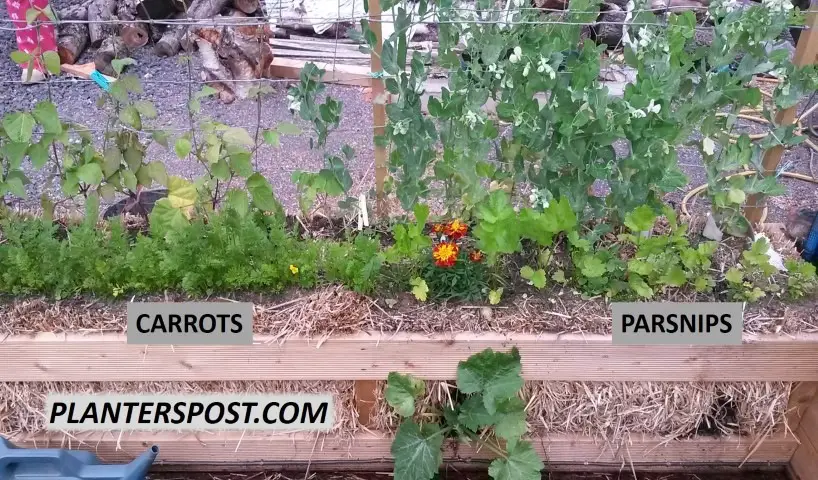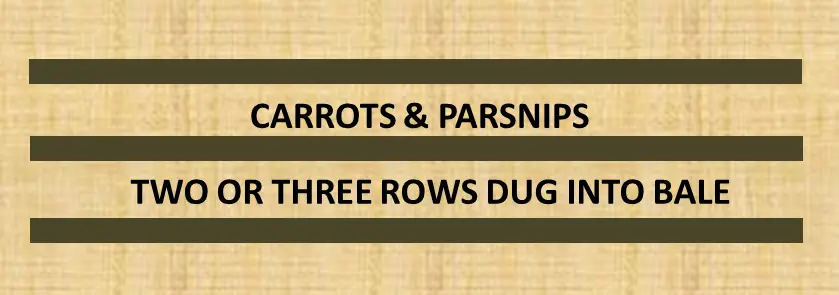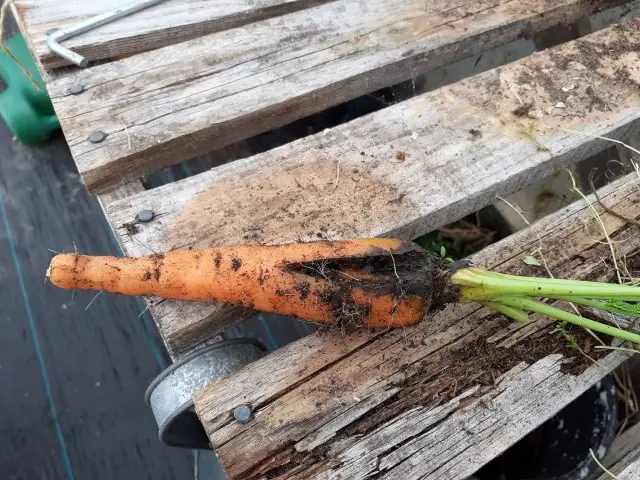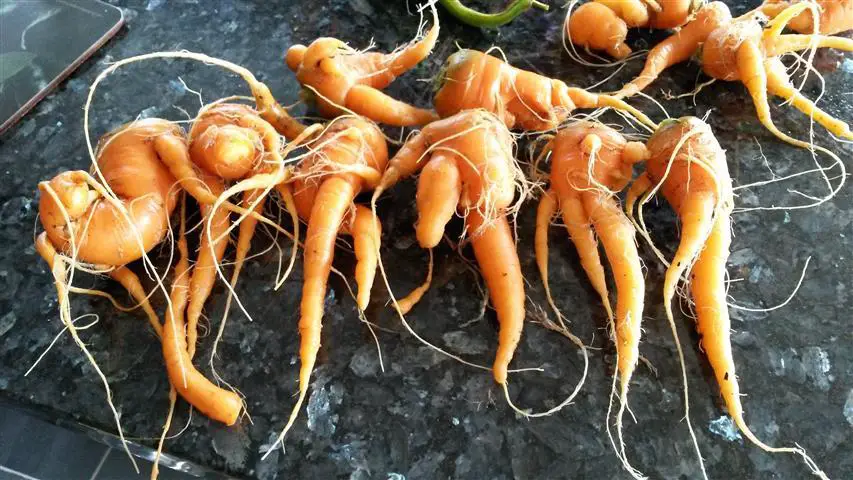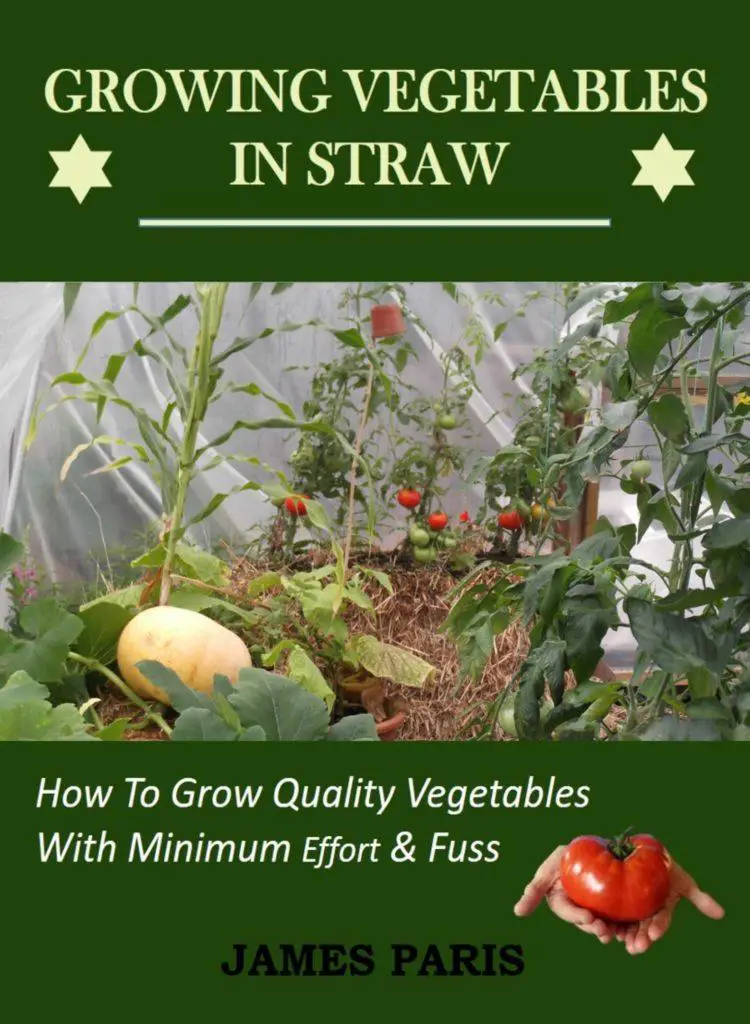Carrots are just one of many vegetables that you can plant and grow successfully in straw or indeed hay bales. However the planting method employed to grow carrots successfully in this way, does need to be followed if you want the carrots to grow straight and strong.
Anyone who has had experience in growing carrots or other deep tap-root vegetable like parsnips, knows full well the issue of twisted or club root carrots that can arise in the traditional or even raised bed garden.
To grow carrots in straw bales, is simply a matter of cutting a trench or 2 down the length of the bale. Part the straw to form a ‘V’ shape and fill in with compost. Thinly sprinkle a line of seeds down the track and lightly cover over with compost. Water in the seeds and cover with garden fleece.
You will find this process in a bit more detail down below this section.
With planting carrots in straw bales the same issue of deformed roots can and will occur, if it is not done correctly. Fortunately the correct way to plant your carrots in straw bales is not difficult, and is as follows…
- Condition or prepare the straw bale for the full period before planting as per the normal straw bale priming procedure.
- Cut 2 or 3 channels longways along the top of the bale as in the image on this page. Part the cut thoroughly in a ‘V’ shape at least 6-9 inches deep.
- Fill in the trenches with a good quality soil/compost mix that includes washed sand, similar to that you would use in a square foot garden mix for carrots.
- Level out the compost and lightly make a shallow score (about ¼ inch deed) down the length of the track and sparsely sprinkle your carrot seeds down the track. Cover over the seeds when done with the soil.
- Water lightly and cover over with garden fleece for protection against weather and carrot fly.
That’s all there is to it – you have now planted your carrots in a straw bale garden. However there are other questions that have to be answered if you are to reap a successful harvest of healthy carrots.
As for the deep trench you have had to make in the straw bale, in case you have not already guessed this trench is simply to give the carrot free passage down into the bale without the roots being caught up in the straw.
Thinning out the carrots
Sow the seed sparingly along the trench so that you do not have to thin them out so much and therby encourage the carrot fly.
rather than pull up the carrots when thinning, simply snip the carrots at the ground surface creating 1 1/2 to 2 inches space between the carrots.
How to protect against the carrot fly
The carrot fly (carrot root fly Psila rosae) is the scourge of the carrot farmer. My own father was put off growing carrots for life, after he lost a complete crop of healthy carrots virtually overnight to the ravages of the carrot root fly grub.
However for you, that need not be the case – especially when growing carrots in straw bales. Why is straw bale gardening different with regard to the carrot fly?
The average straw bale when set up is approximately 16-18 inches high. The flight of the carrot fly is reckoned to be only 18 inches or so. This means that in regards to height, while the straw bale does not make it entirely invulnerable to the carrot fly – it certainly has an advantage to carrots grown at ground level.
The next step to preventing carrot fly damage is to simply cover the bale over with garden fleece or garden micro-mesh such as ‘enviromesh’. The difference between garden fleece vs Enviromesh is explored on this article.
Can you transplant carrots?
In theory at least the answer is yes. However it is a difficult process especially for the beginner gardener. The reason for this is that if you transplant the seedling carrot in the wrong way then you will just end up with a lot of twisted stumped carrot roots come harvest time.
Transplanting seedling carrots has to be done carefully by following these steps.
- Take a stick or use your finger to sink a deep hole into the compost. This must be the full depth of your seedling root when held up.
- Very carefully present your seedling to the hole you have made and let the root fall down to the bottom of the hole WITHOUT TWISTING or bending the root. Gently use a fine stick to poke it down if need be.
- Whilst still holding the seedling so there is no weight on the root. Carefully fill in the hole around the root until you are at surface level then press down the soil lightly to hold the carrot upright.
- Continue this process every 2 inches or so along the track.
By following these steps you have a good chance of growing straight carrots – you will know come harvest time!
Is a straw bale and hay bale the same thing?
Indeed they are not! Hay is made from grass grown to be used as an animal feed as it is full of nutrients and grass seeds. It is also full of nitrogen packed into the dry grass.
Straw bales on the other hand are a ‘nitrogen desert’ and have no value as a feed. Straw is used for bedding animals predominantly, or in a gardeners case for mulching or creating a straw bale garden to grow vegetables.
Hay bales can also be used for growing vegetables by the process of preparing the hay bale is completely different – as you may see in this article on Hay bale vs Straw bale gardening.
SUMMARY:
One of the advantages of growing any vegetable including carrots in straw bales, is that when harvested they come out very clean! No mucky earth clinging to them and hopefully no bugs and critters either!
I just love being able to pluck a carrot from the bale and after a quick rub-down, just eat it raw. The flavour of a fresh grown crunchy carrot is just fantastic.
So if you have not already tried growing carrots in straw bales, I would highly reccomend it – it certainly creates a good talking point with friends and neighbours!

